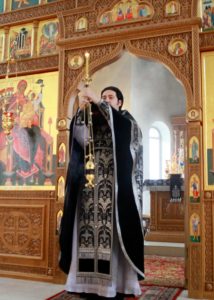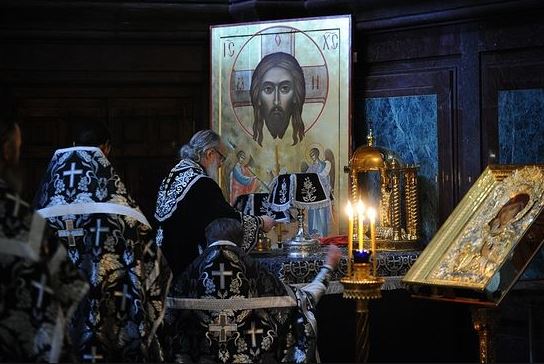On the origins of the Liturgy of the Presanctified Gifts.
By Panagiotis Melikides
 During the period of Great Lent, except Saturdays and Sundays, the Liturgy of the Presanctified Gifts is celebrated, which is the result of two factors. First, during this period the celebration of the Divine Liturgy, which is paschal and festive in character, is inconsistent with the character of the period. Canon 29 of the Synod of Laodicea (363) ruled:
During the period of Great Lent, except Saturdays and Sundays, the Liturgy of the Presanctified Gifts is celebrated, which is the result of two factors. First, during this period the celebration of the Divine Liturgy, which is paschal and festive in character, is inconsistent with the character of the period. Canon 29 of the Synod of Laodicea (363) ruled:
“During the period of Great Lent bread is not offered, except Saturday and Sunday only.”
Canon 51 of the same Synod also forbids the celebration of the memorials of the martyrs on fasting days during Great Lent and requires them to be transferred to Saturday or Sunday, because the celebration of the memorials of the martyrs are connected with the celebration of the Divine Liturgy.
According to the testimonies of the Fathers of the Church (Cf. Basil the Great, Epistle 93 to Caesaria the Patrician, PG 32,484) Christians received Communion regularly on Saturdays, Sundays, Wednesdays, Fridays and as many times during the week the Divine Liturgy was celebrated. The faithful received the Precious Gifts in the way we receive the antidron today. They Communed from a portion of the Body of Christ which is immersed in the Precious Blood, and that which remained was kept so they may receive on days when it was not possible to celebrate the Divine Liturgy.

The same tactic was followed by the hermits, who were alienated from organized monastic communities and were not able to participate in Eucharistic gatherings that took place during the week. To receive Communion properly prepared they formulated a Service. Here is the origin of the Presanctified, which included excerpts from the Divine Liturgy, prayers before and during Communion, and thanksgiving prayers.
The Presanctified does not include essentially anything but the transfer of the presanctified Gifts from the prothesis to the altar, and Communion prayers which are accompanied by preparatory and thanksgiving prayers. The first testimonies for this liturgical type is found in the Chronicon Paschale (7th cent.) and in the Quinisext Ecumenical Synod held in Constantinople in 692
“On every fasting day of Holy Great Lent, except Saturdays and Sundays and the day of the Annunciation, a Presanctified Sacred Liturgy is done.”
In various places different types of the Presanctified Service were formed, which are attributed to James the Brother of our Lord and preserved only in the Diakonika (Codex Sinia 1040), and the Alexandrine attributed to Mark the Evangelist, from which is preserved the prayer “After Receiving the Holy Mysteries” (Codex Paris Gr. 325). It is already seen in the West in the seventh century (Gelasian Sacramentary) and it was only celebrated on Good Friday.
The Presanctified Liturgy of the Byzantine typikon is attributed to several authors (James the Brother of our Lord, Basil the Great, Epiphanios of Cyprus, Gregory the Dialogist, etc.), but none claim authorship of the writing.
In its current form this Service is associated with the monastic Vespers. It should be noted that the typikon of the monasteries prevailed also in parish churches.
In closing we will note that the Presanctified Liturgy was celebrated also in the past on Wednesday and Friday of Cheesefare, as well as Good Friday. Eventually under the influence of the Jerusalem typikon these days were considered liturgically idle. According to the testimony of Nikephoros of Constantinople, the celebration of the Presanctified occurred on every Wednesday and Friday throughout the year, as well as on feasts with strict fast days like the Exaltation of the Holy Cross (September 14).
Today the Presanctified is celebrated every day except Saturdays, Sundays and the feast of the Annunication, from Clean Monday until Holy and Great Wednesday.
Source: Translated by John Sanidopoulos
